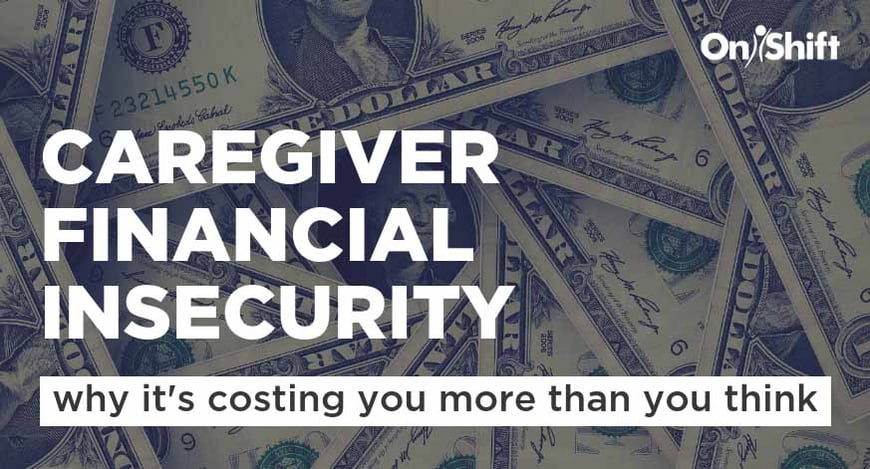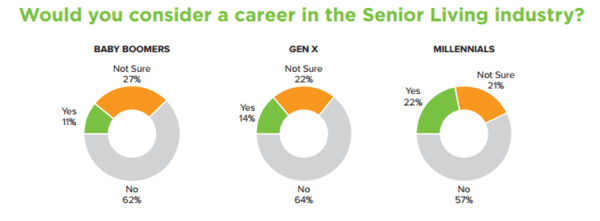September 20, 2018 | Mike Pumphrey
September 20, 2018 | Mike Pumphrey
 15% of Skilled Nursing Assistants Live in Poverty Amid Stagnant Wages. That was the title of the hard-hitting article Skilled Nursing News recently published, which presented several scary statistics from a report via the Paraprofessional Healthcare Institute (PHI).
15% of Skilled Nursing Assistants Live in Poverty Amid Stagnant Wages. That was the title of the hard-hitting article Skilled Nursing News recently published, which presented several scary statistics from a report via the Paraprofessional Healthcare Institute (PHI).
What’s more, the article also points out that “nursing assistants represent the largest single job title in the national nursing home workforce.” That statement right there warrants reiteration: the largest segment of your workforce is financially insecure.
Providers must heed the dire financial situation that many caregivers face for a number of reasons.
Employee Financial Stress Is Costly For Employers
Studies show that financial stress is detrimental to a person’s overall well-being. And this stress isn’t something that employees can just check at the door when they walk into work – it follows them and hinders their performance – often in the form of absenteeism, health issues and workplace accidents.
One study found that 53% of people say that financial trouble interferes with their ability to focus and be productive at work. Another report uncovered that 50% of those who say they’re financially stressed spend three or more hours at work each week thinking about or handling their personal finances.
What’s all of this in terms of dollars? Due to loss of productivity from financially stressed employees, companies with 10,000 workers lose an estimated $3.3 million per year.
Happy, Engaged Staff = Happy, Healthy Residents
The article also makes a very important point: Out of all job groups in a skilled nursing setting, caregivers spend the most the most time with residents. We can’t have the people closest to residents – the ones the residents often form close bonds with and rely on – not showing up for work or unfocused and making errors. As we like to say, happy staff equals happy residents.
The story also states, “Because of their frequent interactions with residents, nursing assistants are well-positioned to observe changes in resident condition and report these changes to licensed nursing staff.” Nurses rely on caregivers and their understanding of the residents they serve, and when they’re not focused, they could miss something critical. When caregivers are stressed and disengaged, resident care can suffer.
The Workforce Shortage Persists
The figures in the report also don’t bode well for an industry that already faces a crippling workforce shortage and high employee turnover. Take a look at these numbers below; the majority of people haven't considered a career in senior care. And as you can imagine, it’s hard to attract people to an industry that’s being advertised as low paying in the news.

When you factor in the competition from retail and other segments hungry for hourly workers, the situation worsens. “The poor quality of nursing assistant jobs and competition from other industries, especially when unemployment rates are low, make it difficult to fill these positions,” PHI policy research associate Stephen Campbell wrote.
There’s Work To Be Done
Campbell wrapped up the report with this: “Rapid growth in the population of older Americans will continue to create a need for nursing homes, even as home and community-based alternatives become available,” He also concludes, “Taken together, these trends make it imperative to develop strategies that strengthen and stabilize this workforce.”
We can’t fold. We have to figure out a way to care for the increasing number of people entering long-term care and assisted living settings. So, how do we do that?
By better marketing the rewarding aspects of senior care to attract employees, creating a winning culture that engages and retains them (including offering some form of financial support or wellness initiative) and ensuring that you have the right leaders and management in place – the kind that drive your mission to the extent that you can feel it throughout every inch of your organization.
Subscribe to the OnShift Blog
Recent Posts
Categories
About Mike Pumphrey
Mike Pumphrey is Vice President of Product Marketing at OnShift. His expertise in staffing and labor management strategies in long-term care and senior living is foundational to his role leading OnShift’s Product Marketing team. Mike works hand-in-hand with state and national associations, senior care providers, and with OnShift’s Customer Success and Product teams to create impactful best practices aimed to help solve the daily workforce challenges in senior care. Mike shares insights, research and recommendations to improve clinical, operational, and financial outcomes through regular blog posts and conference speaking engagements.
See for yourself why thousands of providers rely on OnShift’s innovative software for recruitment, hiring, workforce management, pay and engagement. Request your personalized demo today.
